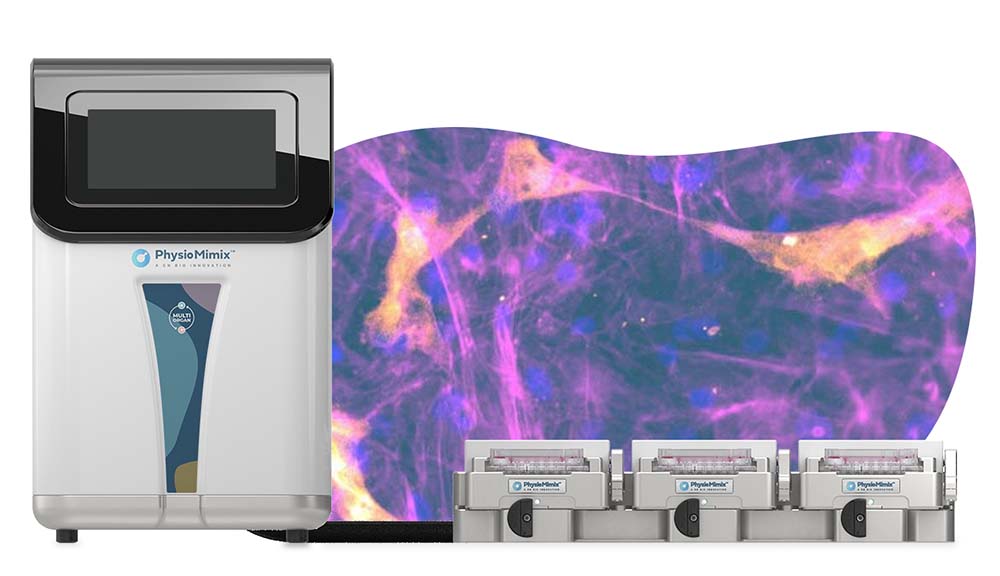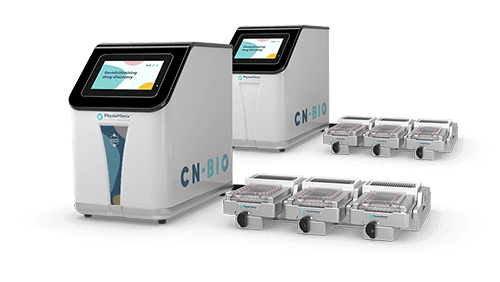When developing drugs, we rely heavily on in vitro, in vivo animal and in silico models to predict how the human body will interact with drugs before clinical testing.
However, the ADME data derived from these models is only as good as the test’s ability to mimic the human response – all have limitations leading to challenges in ADME drug development. Animals suffer from interspecies differences, whilst in vitro assays are simplistic and operate in isolation. In silico models are only as good as the input data sets, frequently requiring first-in-human study data to be “taught”. The problem is further compounded by advanced drug modalities that require a rethink regarding the best tool for the job from the ADME experimental toolbox. Plus, we humans are all different! Our genetic polymorphisms, disease states, age, gender and the drugs we already take also play a part in the way that our bodies interact with drugs.
In this article, we explore six current challenges in profiling preclinical human ADME cited by publications highlighting where advances in the human relevance of preclinical models can improve estimations for safer and more efficient drug development.
#1 How to gain greater insights into human ADME profiles through a broader approach.
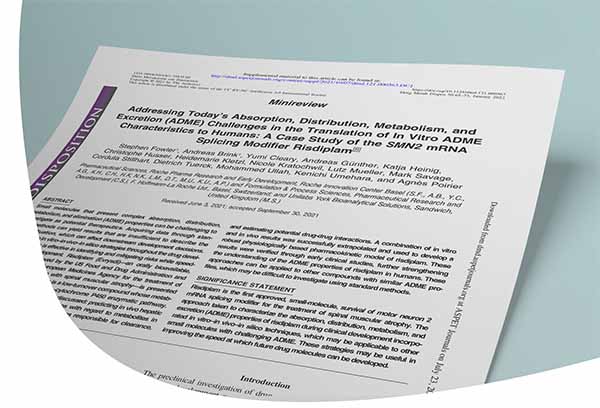
Addressing Today’s Absorption, Distribution, Metabolism, and Excretion (ADME) Challenges in the Translation of In Vitro ADME Characteristics to Humans: A Case Study of the SMN2 mRNA Splicing Modifier Risdiplam. Fowler et al (2022).
Risdiplam is a small molecule approved to treat spinal muscular dystrophy with complex ADME properties including high metabolic stability. Conventional in vitro drug metabolism assays failed to predict the human response to Risdiplam, underestimating in vivo turnover. The authors used a modelling and simulation-based approach (in silico physiological-based pharmacokinetic (PBPK)) in combination with in vitro data and early clinical studies to elucidate a comprehensive picture of the drug’s ADME profile. They argue this “combination approach” provides greater insights when investigating small molecule drugs with complex ADME properties as conventional preclinical approaches alone aren’t good enough.
Is it time to supplement your preclinical toolbox further with more advanced in vitro multi-organ gut/liver models to iteratively improve ADME estimations before first-in-human studies?
#2 How to account for human and population differences in intestinal metabolism
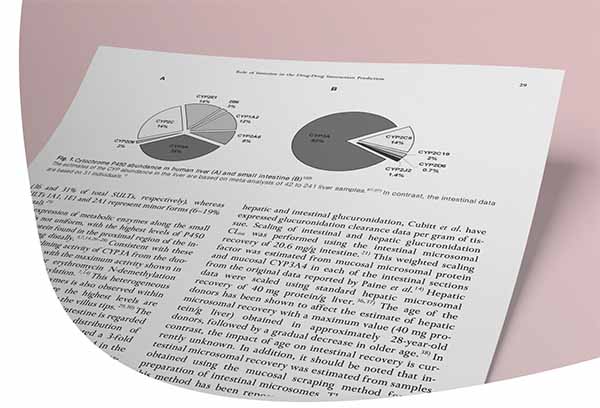
Contribution of Intestinal Cytochrome P450-Mediated Metabolism to Drug-Drug Inhibition and Induction Interactions. Galetin et al (2010).
This review focuses on the role of intestinal cytochrome P450 (CYP) enzymes in drug-drug interactions (DDIs). Intestinal CYP enzymes are present in the gut where they play a crucial role in metabolizing drugs before they reach systemic circulation – which can significantly affect a drug’s bioavailability. The review discusses how current DDI prediction models often don’t fully account for intestinal CYP activity, potentially leading to inaccurate predictions. The authors recommend incorporating data on intestinal CYP metabolism into DDI prediction models to improve their accuracy and highlight the need for better methods to assess intestinal CYP activity and variability among individuals.
Whilst traditional Caco-2 cell assays offer a quick and easy method of estimating drug absorption, some CYPs are missing and the levels of expressed CYPs are generally lower and varied compared to the human intestine. This can contribute to estimation discrepancies. Additionally, this cell line approach does not offer the potential to study donor-to-donor population differences. Advanced in vitro models utilizing primary human intestinal cells that are fluidically linked to human liver models provide a unique path to overcome these limitations for a more accurate estimation of a drug’s first-pass metabolism and bioavailability in humans.
#3 Overcoming the weak correlation between animal and human bioavailability data
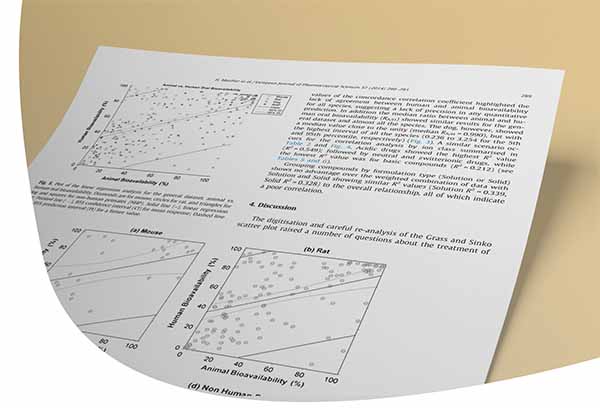
Animal versus human oral drug bioavailability: do they correlate? Musther et al (2014).
Estimating the bioavailability of drugs in humans during preclinical development is necessary to set safe and effective doses in the clinic. This seminal study investigating 184 compounds found that bioavailability data from commonly used animal models weakly correlates with human data (mouse R2 = 0.25, rat =0.28, and dog = 0.37). Non-human primate (NHP) models provide an improved bioavailability correlation with humans (R2 =0.69), although these models are not commonly used due to significant ethical considerations, stringent regulatory requirements, and high cost. The overall correlation between animal and human bioavailability is poor mainly due to differences in physiology and metabolic capacity. Whilst these data do not eliminate the usefulness of animal models for pharmacokinetic analysis, it highlights that these studies are best used as qualitative indicators, rather than quantitative data.
A new human-relevant approach, which combines oral absorption and hepatic metabolism, is required to more accurately estimate human drug bioavailability in vitro to help circumvent this challenge in ADME drug development.
#4 How to rationalize drug design with earlier use of in silico modeling
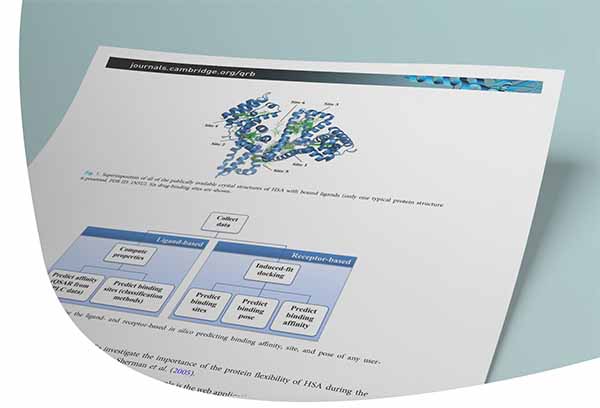
In silico ADME/T modelling for rational drug design. Wang et al (2015).
One of the most important innovations in modern drug development has been the adoption of computational or in silico tools to screen for new compounds and predict ADME behavior from a compound’s chemical structure. Clinical behavior can be forecasted using PBPK modelling, which combines a compound’s chemical properties, the physiology-based properties of the population being modelled, and data from ADME studies.
In this article, the authors argue that in-depth ADME testing is carried out too late, only when a limited number of candidate compounds have been identified. To improve R&D efficiency, in silico methods should be used in early drug discovery to enable parallel optimisation of compound efficacy and “druggability properties”. The future implementation and success of in silico models will in part, however, depend on the quality of models and the quality of in vitro data fed into the models. Organ-on-a-chip (OOC) technology provides a tool to generate more physiologically relevant ADME data compared to traditional in vitro approaches. This presents an opportunity for OOC and PBPK to be integrated into a workflow, where higher-quality input data leads to improved population predictions.
#5 Does the increasing complexity of advanced drug modalities require a rethink of the ADME toolbox?
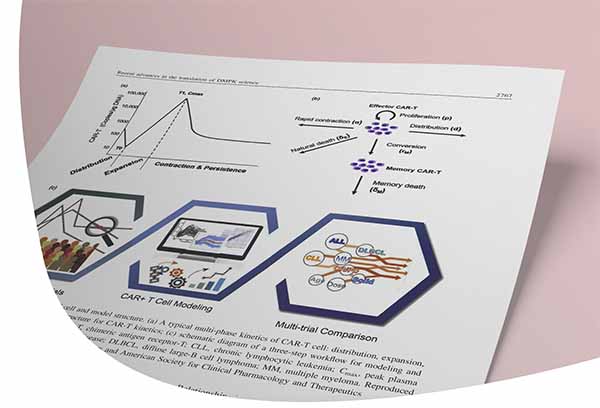
Recent advances in the translation of drug metabolism and pharmacokinetics science for drug discovery and development. Yurong et al (2022).
The authors highlight the tremendous progress made in the last decade to understand ADME properties of candidate drugs with progress, in part, driven by the adoption of high-throughput screening in the ADME workflow. As the landscape of compounds changes beyond traditional small molecules to large molecules and biologics, they argue the need for further innovation in experimental tools to improve the characterization of their ADME properties.
This is particularly important for newer modalities designed for oral dosing, as they tend to suffer from poor bioavailability. A good example is PROteolysis TArgeting Chimera (PROTACs), which have emerged as a promising new chapter in drug discovery but are challenging to develop because they are molecules with high molecular weight, poor solubility and low permeability. Here emerges a need for drug developers to improve PROTAC bioavailability to unlock their full therapeutic potential. Tools such as OOC that uniquely offer the ability to profile oral bioavailability in vitro enable drug developers to test strategies to improve oral bioavailability. Example strategies may include, developing a prodrug form of the PROTAC and improvements to cellular permeability through changes to the PROTAC chemistry.
#6 Navigating the preferred (oral) administration route for new modality drugs
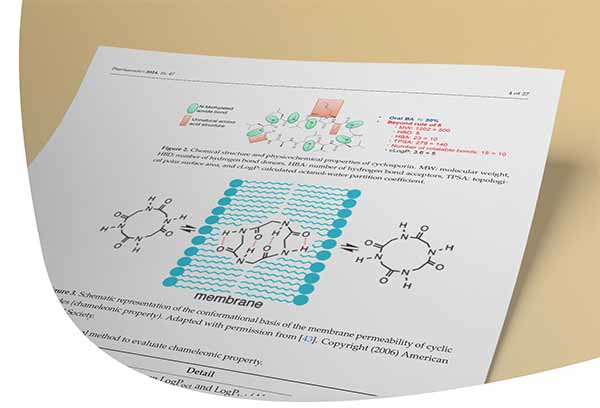
Oral absorption of middle-large molecules and its improvement, with a focus on new modality drugs. Asano et al (2023).
This article explores challenges in orally delivering middle-to-large molecules, a desirable route for drug administration. These molecules are typically poorly absorbed due to their size. The authors discuss the limitations of traditional methods and the need for improved absorption enhancers or modifications to the drugs themselves. They highlight recent successes like Rybelsus and Mycapssa, tablets containing absorption enhancers that allow oral delivery of peptide drugs for diabetes and acromegaly. However, even with these advancements, oral bioavailability remains low. The article emphasizes the ongoing efforts to develop new strategies for effective oral delivery of these promising therapeutic molecules and discrepancies in the amount of absorption enhancers required to improve oral administration between non-clinical in vivo animal studies and clinical human studies.
The use of advanced in vitro human models to further their development could offer a path forward to ensure that dosages are feasible in humans before clinical studies commence.
In the last decade, microphysiological systems (MPS), also known as organ-on-a-chip (OOC), have shown their potential to address ADME challenges in drug development and improve the human translatability of ADME studies. MPSs are designed to recapitulate the structural and functional biomarkers of cells and tissues in a physiologically relevant manner through the culture of primary human cells on perfused scaffolds. Efforts to improve the in vitro to in vivo translation of drug efficacy and safety data have led to more complex MPS from CN Bio where multiple organs, such as the gut and liver, are fluidically linked to simulate processes such as drug absorption and first-pass metabolism. Through this unique approach, it is now possible to profile human drug bioavailability in vitro. Broadening the ADME toolbox with advanced human in vitro assays enables better-informed decisions to reduce the risk of identifying poor oral bioavailability during first-in-human studies.
So, don’t delay tackling challenges in ADME drug development! The longer you wait, the greater the risk of cascading problems from miscalculated pre-clinical estimations. The PhysioMimix® primary human in vitro Gut/Liver model and Bioavailability Assay can be recreated in your laboratory using the Bioavailability assay kit: Human 18, or accessed via our ADME Contract Research Services.
